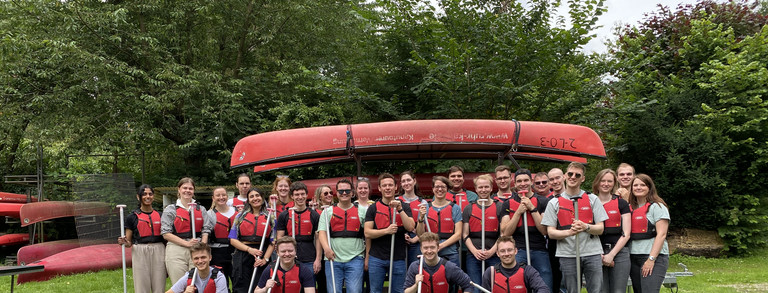Dr. Bernhard Burghoff

Curriculum Vitae
Bernhard Burghoff studied chemical engineering at the University of Dortmund and at Lehigh University, Bethlehem, Pennsylvania, USA.
During his studies, he was also involved in investigations into the ZeaChem process for alternative ethanol production from sugar production process streams (e.g. molasses) at the Sugar Research Institute in Mackay, Australia, in 2003.
He then completed his studies in February 2004 at the University of Dortmund with an external diploma thesis at Cognis Deutschland GmbH & Co. KG in Düsseldorf with the topic "Extraction of lycopene from tomato processing residues".
After almost a year of project work in the field of fuel cells at the University of Duisburg-Essen in Essen, he began his doctoral thesis in 2005 with the topic "Solvent Impregnated Resins for the Recovery of Low Concentration Ethers and Phenols from Water" at the Universiteit Twente in Enschede, the Netherlands.
In 2006, he moved with the chair to the Technical University of Eindhoven, the Netherlands. After six months as a postdoc at the TU Eindhoven (topic: analysis of ionic liquids), he accepted a position as group leader in the field of innovative downstream processing at the TU Dortmund University, Chair of Plant and Process Engineering, in September 2009. He left the TU Dortmund in 2011.
Field of Research
The processing of biotechnological media is very costly due to large process flows and low product concentrations. The isolation of the target component is nowadays usually the most cost-intensive item, accounting for up to 80% of the total production costs. Therefore, the working group "Innovative Downstream Processes" is intensively researching alternative processing strategies. The working group covers a broad spectrum of downstream processing technologies between the first separation steps after fermentation and the fine purification of the target component.
The first separation step is foaming. This is a process in which the fermentation broth is selectively gassed. The (target) proteins contained in the broth adsorb on the gas-liquid interface of the gas bubbles and form a stable foam. The foam is collapsed separately. The resulting liquid foamate contains the concentrated enzyme. Using the investigated example of a cutinase, 80% of the enzyme contained in the broth can thus be recovered. Thus, it could be shown that foaming of the fermentation broth as a first purification step can replace expensive chromatographic separation sequences. The research includes the determination of the design parameters for a flexible continuous foaming process that can be used to purify different fermentation broths.
As a further alternative work-up step, liquid-liquid chromatography in a centrifugal field is investigated. The chromatographic separation of diterpenoids using two different solvent mixtures serves as a concrete example. With the existing experimental setup, different diterpenoid fractions are separated in batch mode with up to 100% yield and high purity. The aim is, among other things, a continuous operation and the precise investigation of the hydrodynamics within the chambers of the rotor.
In the field of solid-liquid chromatography, work is being done on the design and scale-up of chromatographic separation sequences using neural networks. For this purpose, isothermal parameters are calculated and experimentally validated on the basis of peak curves for different process concepts (batch, simulated moving bed, steady state recycling chromatography, closed loop recycling chromatography, etc.). Based on this, the most promising chromatographic separation option will be selected and the design and operating parameters as well as the cost parameters will be optimised. In addition, the development of chromatographic solid phase gradients for the purification of natural product extracts will be investigated in another project.
The topic of crystallisation as a fine purification step is being worked on in collaboration with the Chair of Thermodynamics. Research topics in this area include nucleation by ultrasound or gassing as an alternative to cooling crystallisation or inoculation. On the other hand, crystal growth in solvent mixtures is investigated on the single crystal. The aim is, among other things, to reduce agglomeration and change the crystal shape, which is important for further process steps. In addition, scale-up factors for crystallisation are determined on a glass crystallisation stand on a pilot plant scale.
In addition to the broad technical scope of the working group, special attention is paid to the behaviour of protein molecules at phase interfaces or when passing through phase interfaces. It will be investigated to what extent different target enzymes unfold at the different interfaces (e.g. gas-liquid, liquid-liquid) and what influence this has on the success of the separation of substances. The aim is to expand our understanding of the intrinsic mechanisms of protein purification and to build a bridge between protein structure and process design.
Publications
Paper
- J. Merz, B. Burghoff, H. Zorn, G. Schembecker
Continuous foam fractionation: Performance as a function of operating variables
Separation and Purification Technology, 82 (2011) 10–18, (doi.org/10.1016/j.seppur.2011.07.023)
- D. Bergs, B. Burghoff, M. Joehnck, G. Martin, G. Schembecker
Fast and isocratic HPLC-method for steviolglycoside analysis from stevia rebaudiana leaves
Journal of Consumer Protection and Food Safety, Volume 7, Issue 2, Page 147-154 (2012), (Article)
- B. Burghoff, D. Bergs, M. Joehnck, G. Martin, G. Schembecker
Purification of rebaudioside A from stevia rebaudiana Bertoni
In: Geuns, Jan M.C. (Ed.), Stevia: Break-through in Europe. Euprint, Heverlee, (2011) p.167-178, ISBN: 978-90-742-53192
- Merz, J.; Zorn, H.; Burghoff, B.; Schembecker, G. (2010).
Purification of a Fungal Cutinase by Adsorptive Bubble Separation: A Statistical Approach
Colloids and Surfaces A: Physicochemical and Engineering Aspects 382 (2011) 81–87, (doi.org/10.1016/j.colsurfa.2010.12.007)
- Burghoff, B.; Schembecker, G. (2010).
Innovative Downstream-Prozesse
Chemie-Ingenieur-Technik, 82 (9) 1521.
- B. Burghoff, G. Schembecker, (2010)
Aufarbeitung: Entwicklung alternativer Verfahren zur Vermeidung des Bottlenecks in der biotechnologischen Produktion
Chemie & more, 4, p.22-24.
- Burghoff, B.; Sousa Marques, J.; van Lankvelt, B. M.; de Haan, A. B. (2010).
Solvent impregnated resins for MTBE removal from aqueous environments
Reactive and Functional Polymers, 70 (1) 41–47, (doi.org/10.1016/j.reactfunctpolym.2009.10.002)
- Burghoff, B.; de Haan, A. B. (2009).
Liquid-liquid equilibrium study of phenol extraction with Cyanex 923
Separation Science and Technology, 44 (8) 1753-1771, (doi.org/10.1080/01496390902775927)
- Burghoff, B.; Schiferli, J.; Sousa Marques, J.; de Haan, A. B. (2009).
Extractant screening and selection for methyl tert-butyl ether removal from aqueous streams
Chemical Engineering Science, 64 (12) 2887-2892, (doi.org/10.1016/j.ces.2009.03.025)
- Burghoff, B.; Cuypers, R.; van Ettinger, M.; Sudhölter, E. J. R.; Zuilhof, H.; de Haan, A. B. (2009).
Evaluation of tri n octylamine oxide as phenol extractant in a solvent impregnated resin
Separation and Purification Technology, 67 (1) 117-120, (doi.org/10.1016/j.seppur.2009.03.026)
- Burghoff, B.; Zondervan, E.; de Haan, A. B. (2009).
Phenol extraction with Cyanex 923: Kinetics of the solvent impregnated resin application
Reactive and Functional Polymers, 69 (4) 264-271, (doi.org/10.1016/j.reactfunctpolym.2009.01.005)
- Burghoff, B.; Goetheer, E. L. V.; de Haan, A. B. (2008).
Solvent impregnated resins for the removal of low concentration phenol from water
Reactive and Functional Polymers, 68 (9) 1314-1324, (doi.org/10.1016/j.reactfunctpolym.2008.06.009)
- Cuypers, R.; Burghoff, B.; Marcelis, A. T. M.; Sudhölter, E. J. R.; de Haan, A. B.; Zuilhof, H. (2008).
Complexation of phenols and thiophenol by phosphine oxides and phosphates. Extraction, isothermal titration calorimetry and ab initio calculations
Journal of Physical Chemistry A, 112, 11714-11723, (doi.org/10.1021/jp801605y)
- Burghoff, B.; Goetheer, E. L. V.; de Haan, A. B. (2008).
COSMO-RS-Based Extractant Screening for Phenol Extraction as Model System
Industrial and Engineering Chemistry Research 47 (12) 4263 - 4269, (doi.org/10.1021/ie7017405)
- Burghoff, B.; van der Ham, A. G. J.; de Haan, A. B. (2006).
Extractant Screening for Phenol Extraction Using the Conductor-like Screening Model
Chemie-Ingenieur-Technik 78 (9) 1304, (doi.org/10.1002/cite.200650314)
Oral presentations
- B. Burghoff (2010).
Innovative downstream processes
28. DECHEMA-Jahrestagung der Biotechnologen und ProcessNet-Jahrestagung, Aachen
- Burghoff, B.; de Haan, A. B. (2008).
Development of a solvent impregnated resin as an alternative phenol removal technology,
Jahrestreffen des ProcessNet-Fachausschusses Extraktion und des Arbeitskreises Phytoextrakte, Clausthal-Zellerfeld, Deutschland.
- Burghoff, B.; Goether, E. L. V.; de Haan, A. B. (2007).
Extractants for Phenol Recovery by Solvent Impregnated Resins,
Netherlands Process Technology Symposium (NPS7), Veldhoven, Niederlande.
- Burghoff, B.; Schiferli, J.; van der Ham, A. G. J.; de Haan, A. B. (2007).
Treatment of Aqueous Streams by Recovery of Ethers with Solvent Impregnated Resins,
Conference on Environmental Science and Technology (CEST), Kos, Griechenland.
- Burghoff, B.; de Haan, A. B. (2007).
Extractants for Phenol Recovery by Solvent Impregnated Resins,
Fachtagung AEM, Asselheim, Deutschland.
- Burghoff, B.; van der Ham, A. G. J.; de Haan, A. B. (2006).
Extractant for Phenol Recovery by Solvent Impregnated Resins,
2nd International Conference on Environmental Science and Technology (ICEST), Houston, USA.
Poster presentations
- Burghoff, B.; de Haan, A. B. (2008).
Phenol Removal from Aqueous Streams using Solvent Impregnated Resins,
Netherlands Process Technology Symposium (NPS8), Veldhoven, Niederlande.
- Burghoff, B.; Goether, E. L. V.; de Haan, A. B. (2008).
Phenol Removal from Dilute Aqueous Streams using Solvent Impregnated Resins,
International Solvent Extraction Conference (ISEC), Tucson, USA.
- Goetheer, E. L. V.; Burghoff, B.; de Haan, A. B. (2007).
Strategies for Prediction of Solvent Polarity of Ionic Liquids using COSMO-RS,
2nd International Congress on Ionic Liquids (COIL-2), Yokohama, Japan.
- Burghoff, B.; van der Ham, A. G. J.; de Haan, A. B. (2007).
Solvent Impregnated Resins for Purification of Phenolic Waste Water Streams,
9th International Conference on Fundamentals of Adsorption (FOA9), Sizilien, Italien.
- Burghoff, B.; van der Ham, A. G. J.; de Haan, A. B. (2006).
Extractant Screening and Molecular Design for Phenol Extraction using the COSMO-RS Theory,
Netherlands Process Technology Symposium (NPS6), Veldhoven, Niederlande.
- Burghoff, B.; van der Ham, A. G. J.; de Haan, A. B. (2006).
Extractant Screening for Phenol Extraction using the Conductor-Like Screening Model,
GVC-DECHEMA Jahrestagungen, Wiesbaden, Deutschland.
- Burghoff, B.; van der Ham, A. G. J.; de Haan, A. B. (2005).
Solvent Impregnated Resins (SIRs) for the Recovery of Low Concentration Ethers and Phenols from Water,
Netherlands Process Technology Symposium (NPS5), Veldhoven, Niederlande.
Patents
- G. Schembecker, B. Burghoff, F. A. van Winssen
Verfahren zur Trennung/Reinigung von Biomolekülen
AZ 10 2011 001 743.7, applied April 1st, 2011



